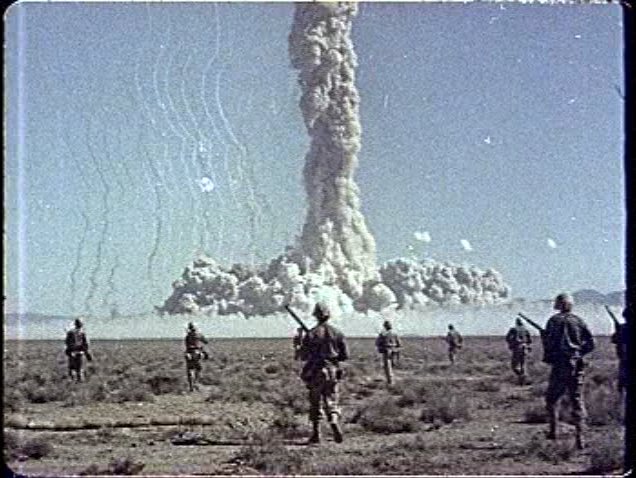Operation Plumbbob was a series of 29 nuclear tests conducted by the U.S. military between May 28 and October 7, 1957, at the Nevada Test Site. It was one of the longest and most comprehensive test series in the continental United States, and became controversial after much of the operation was declassified. There were several objectives during Operation Plumbbob, including improving tactical weapon design, conducting bio-medical experiments, safety testing, and component and design testing for thermonuclear systems to be detonated in future operations.
Purpose
While most of the shots conducted during Plumbbob were intended to test design principles for nuclear warheads that would be mounted on intercontinental and intermediate range missiles, warheads with smaller yields were also tested to develop and improve air defense and anti-submarine weapon systems. The military also wanted to understand nuclear blast effects on civil and military structures as well as various aircraft. During one test, a large blimp was subjected to the shock-wave from the nuclear detonation; it collapsed within seconds.
Scientists were also concerned with the effects of radiation on biological life. To study these effects, over 1,200 pigs were subjected to bio-medical experiments and blast-effects studies during Operation Plumbbob. During one test, pigs were placed in cages and provided with suits made of different materials to test which materials provided best protection from the thermal pulse generated by the nuclear blast. While most of the pigs survived, many suffered third-degree burns to 80% of their bodies. In another test, pigs were placed in pens behind large panels of glass at various distances from the epicenter of the nuclear detonation to examine the effects of flying debris on living targets.
Another objective during Operation Plumbbob was to understand how the average foot-solder would perform, physically and psychologically, under the rigors of a tactical nuclear battlefield. Over 16,000 members of the U.S. Air Force, Army, Navy and Marines participated in exercises Desert Rock VII and VIII, a joint field operation which involved the largest troop maneuver associated with U.S. nuclear weapon testing in history.
Military officials were also concerned with radiation contamination and fallout from an accidental detonation of a nuclear weapon. On July 26, a safety experiment, “Pascal-A,” was detonated in an uncapped hole at the Nevada Test Site, becoming the first underground shaft nuclear test. The knowledge gained here wou ld provide data to prevent nuclear yields in case of accidental detonations (plane crash, etc.). The Rainier shot, conducted September 19, 1957, was the first fully contained underground nuclear test, meaning that no fission products escaped into the atmosphere. This test of 1.7 KT could be detected around the world by seismologists using ordinary seismic instruments. The Rainier test became the prototype for larger and more powerful underground tests.
ld provide data to prevent nuclear yields in case of accidental detonations (plane crash, etc.). The Rainier shot, conducted September 19, 1957, was the first fully contained underground nuclear test, meaning that no fission products escaped into the atmosphere. This test of 1.7 KT could be detected around the world by seismologists using ordinary seismic instruments. The Rainier test became the prototype for larger and more powerful underground tests.
Controversy
Operation Plumbbob’s controversial legacy stemmed from the enormous amount of radiation released into the atmosphere during the nuclear testing phase. Recently declassified documents reveal that the Plumbbob test series released approximately 58,300 kilocuries of radioiodine (I-131) into the atmosphere over a four month period. This produced total civilian radiation exposures amounting to 120 million person-rads of thyroid tissue exposure (about 32% of all exposure due to continental nuclear tests). In addition to civilian exposure, troop exercises conducted near the ground near shot “Smoky” exposed over three thousand servicemen to relatively high levels of radiation. A survey of these servicemen in 1980 found significantly elevated rates of leukemia.
Videos from the Plumbbob test series can be found on AHF’s YouTube channel.





) LA-UR-06-1068.jpg)